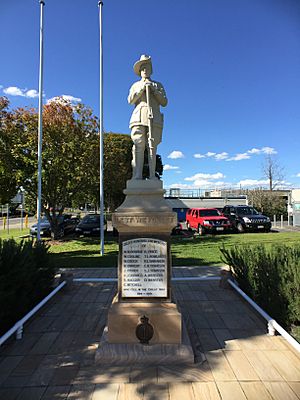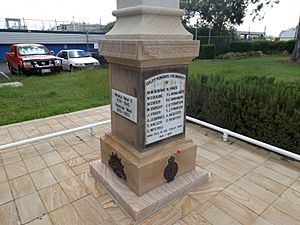Oxley War Memorial facts for kids
Quick facts for kids Oxley War Memorial |
|
|---|---|

The memorial is partially surrounded by rosemary
|
|
| Location | 1218 Oxley Road, Oxley, Queensland, Australia |
| Design period | 1919–1930s (interwar period) |
| Built | 1920 |
| Official name: Oxley War Memorial, Oxley Memorial Park, Oxley Place | |
| Type | state heritage (landscape, built) |
| Designated | 4 July 2006 |
| Reference no. | 602447 |
| Significant period | 1920s (historical) ongoing (social) |
| Significant components | views to, garden/grounds, memorial – soldier statue, memorial – plaque, trees/plantings, fencing |
| Lua error in Module:Location_map at line 420: attempt to index field 'wikibase' (a nil value). | |
The Oxley War Memorial is a special monument in Oxley, Queensland, Australia. It stands at 1218 Oxley Road and was built in 1920. This memorial helps us remember the brave soldiers who served in wars, especially those from the local area. It is also known as Oxley Memorial Park. This important site was added to the Queensland Heritage Register on 4 July 2006.
Contents
Why Was the Memorial Built?
Today, the Oxley War Memorial sits on a small hill where Oxley Road and Bannerman Street meet. It is a very important sight on this busy road.
The memorial was first put up by local people. It was placed on a small piece of land at the corner of Oxley Road and Ipswich Road. The memorial was officially revealed on Saturday, 12 February 1921. Mrs. Elphinstone, whose husband was a local politician, did the unveiling.
In 1929, the Brisbane City Council took over the land where the monument stood. The memorial was later moved to its current spot in the 1980s. This move happened because of new traffic plans for the area.
Who Paid for the Memorial?
The memorial cost about £110 to build. This money was collected from people in the community. A company called F Williams & Co from Ipswich built the memorial. They were stone workers, also known as masons.
F Williams & Co built many other memorials in Queensland. Some of these include memorials in:
- Toogoolawah and One Mile (1917)
- Colinton and Mount Alford (1918)
- Booval and Bundamba (1919)
- Boonah and Maroon (1920)
- Esk and Nundah (1921)
- The Weeping Mother Memorial at Gatton (around 1922)
- Warwick (1923-24)
- Ipswich Cemetery Cenotaph (1932)
The Meaning of War Memorials
Before the First World War, Australia did not have many public monuments. The memorials built after this war became our first national monuments. Australia lost 60,000 soldiers from a population of about four million people. This was a huge number for the country.
Even before the war ended, people started building memorials. These monuments were a way to show their sadness and respect. For those who built them, these places were like sacred graves. They were substitute graves for the Australians whose bodies were buried in battlefields far away. The word "cenotaph" means "empty tomb." This is because the soldiers' bodies were not there.
Remembering All Who Served
Australian war memorials are special because they often remember everyone who served, not just those who died. Australians were proud that their first big army was made up entirely of volunteers. These men were seen as worthy of honor, whether they died or not. Many memorials list all the names of people from a local area who served. This helps us understand how much the community was involved in the war.
The "Digger" Statue
War memorials also show us how people felt about their country and the British Empire. They show the skills of local stone workers and artists. In Queensland, the "digger" statue was a very popular choice for memorials. In other states, like those in the south, tall stone pillars called obelisks were more common.
The "digger" statue is the most common type of memorial in Queensland. Communities chose it because it showed the ANZAC spirit. This spirit represents qualities like loyalty, courage, youth, and strength. The Oxley Memorial Park is a great example of this type of memorial.
Anzac Day and the Memorial
War memorials are very important places for local communities. They are the main spot for annual ceremonies on Anzac Day, which is on April 25. Anzac Day is Australia's national day to remember all those who have died in wars. The dawn ceremony, the minute of silence, and the bugle call of the Last Post are very moving experiences. The Oxley War Memorial helps the local community feel this strong connection to history.
What Does the Memorial Look Like?
The Oxley War Memorial stands in the northwest part of a small, rectangular park. This park is at the corner of Oxley Road and Bannerman Street. The park has grassy areas, pretty planted beds, trees, and play equipment for children.
The monument itself is made of sandstone and marble. It stands on a low, stone base called a plinth. Stone pavers surround this base. A stepped sandstone platform, called a pedestal, holds a sandstone soldier figure. This soldier faces west. He is an Australian "little digger" with a slouch hat and a "rising sun" badge. He stands at ease, with his hands resting on his rifle.
Small stone posts stand at each corner of the paved area. Metal rails connect these posts. There are also decorative gardens on the north and south sides of the paved area. Three flagpoles stand to the east of the monument.
The "Little Digger" Statue
The "little digger" statue is on top of the base. The soldier stands with his head slightly bowed. His rifle rests on his left boot. His hands are crossed and rest on the rifle's butt. A tree trunk behind him helps support the statue.
Plaques and Names
On the west side of the monument, there is a marble plaque. It lists the names of those from the district who died in the First World War. It reads:
OXLEY HONOURS THE MEMORY OF W. M. BOURKE R. PRICE W. COOLING T. L. ROWLANDS W. CROCK R. L. SINNAMON M. ENRIGHT C.H. TOWNSON J. FISHER S.J. TOWNSON A. J. GIBBINGS A. WEBSTER S. HAGGER D. WEBSTER C. MITCHELL WHO FELL IN THE GREAT WAR 1914-1919
Smaller marble plaques on the north and south sides remember other wars. These include the Second World War (1939–45), the Korean War (1950-53), the Malayan Emergency (1950–60), Borneo, and the Vietnam War (1962–72). Bronze military badges from the Australian Armed Services are also fixed to the bottom of the pedestal.
Why is it a Heritage Site?
The Oxley War Memorial was added to the Queensland Heritage Register on 4 July 2006. This means it is a very important historical place.
Showing Queensland's History
The memorial helps us understand Queensland's history. It shows how communities across the state remembered soldiers after the First World War. It also shows a time when Australians felt very patriotic and proud of their country. The monument lists the names of those who died, which is a unique historical record. It also shows what people liked in terms of design during that time.
A Special Type of Memorial
Unveiled in 1920, the Oxley memorial is a great example of a monument built to remember a major historical event. It uses the right materials and design to last a long time. As a "digger" statue, it is also the most popular type of memorial found in Queensland.
Beautiful and Important
The Oxley War Memorial is a very important sight on the street. It stands out as a serious and thoughtful landmark in its park setting. The "little digger" statue shows excellent skill and design, making it very beautiful.
Connecting with the Community
The Oxley War Memorial has a strong and ongoing connection with the local community. It reminds people of the district's involvement in the First World War. The newer additions, remembering other wars, show that the memorial continues to be important. It is a key place for the community's annual Anzac Day services.
The Work of a Famous Artist
The sandstone sculpture of the "little digger" is a wonderful example of the work of Frederick Williams. He was a stone worker and sculptor from Ipswich, Queensland. Williams created many First World War memorials in the Brisbane River Valley and Ipswich areas. It is believed that he used his 14-year-old son as the model for this statue and his other "little digger" figures.


